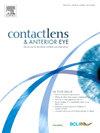应用前段光学相干断层扫描评估巩膜张力引起的晶状体屈曲和接触差。
IF 3.7
3区 医学
Q1 OPHTHALMOLOGY
引用次数: 0
摘要
目的:利用前段光学相干断层扫描(AS-OCT)确定巩膜张力对晶状体接触程度和体内屈曲的影响,并确定与晶状体离体有关的变量。方法:采用Pentacam角膜巩膜轮廓仪(CSP)测量10例角膜正常的健康青年(22±2岁)15 mm处的巩膜张力。参与者配戴相同的16.0 mm旋转对称巩膜晶状体设计(六边形A材料)。利用AS-OCT结合ImageJ分析记录晶状体在15mm弦主圆环经络处的接触差异,并评估晶状体屈曲。此外,还测量了中心流体储层(FR)深度和透镜体分散度。结果:巩膜环度(平均155±95 μm)与晶状体屈曲大小、15 mm弦径处巩膜环度主经络晶状体接触差值有显著相关(r = 0.83, p = 0.003, rs = 0.83, p = 0.005)。平均晶状体离体值为颞下净离体0.30±0.18 mm,颞下离体0.26±0.16 mm,颞下离体0.13±0.1 mm。这与中心FR深度显著相关(rs = 0.91, p = 0.0005和rs = 0.73, p = 0.02和rs = 0.71, p = 0.03)。晶状体离体与巩膜张力无显著相关性(p < 0.05)。结论:巩膜张力与AS-OCT测量的晶状体屈曲和接触视差有显著相关性。减少中央FR深度似乎是一个很好的策略,以改善镜头集中。虽然沿环面子午线平衡晶状体接触有利于解决晶状体挠曲,但这对集中的影响不太清楚。本文章由计算机程序翻译,如有差异,请以英文原文为准。
Assessing scleral toricity induced lens flexure and contact disparity using anterior segment optical coherence tomography
Purpose
To determine the influence of scleral toricity on the extent of lens contact and in-vivo flexure using anterior segment optical coherence tomography (AS-OCT), and to identify variables related to lens decentration.
Methods
Scleral toricity at a chord of 15 mm was measured using Pentacam corneoscleral profilometry (CSP) from 10 healthy young participants (22 ± 2 years) with normal corneas. Participants were fitted with the same 16.0 mm rotationally symmetric scleral lens design (hexafocon A material). AS-OCT was used in conjunction with ImageJ analysis to document the disparity of lens contact at the 15 mm chord primary toric meridians and to assess lens flexure. Additionally, central fluid reservoir (FR) depth and lens decentration were measured.
Results
A significant correlation was found between scleral toricity (mean 155 ± 95 μm) and both the magnitude of lens flexure, and the disparity in lens contact between the scleral primary toric meridians at the 15 mm chord diameter (r = 0.83, p = 0.003 and rs = 0.83, p = 0.005 respectively). Mean lens decentration values were 0.30 ± 0.18 mm inferior-temporal net decentration, 0.26 ± 0.16 mm inferior decentration and 0.13 ± 0.1 mm temporal decentration. This was significantly associated with central FR depth (rs = 0.91, p = 0.0005 and rs = 0.73, p = 0.02 and rs = 0.71, p = 0.03 respectively). No significant correlation was found between lens decentration and scleral toricity (p > 0.05).
Conclusion
Scleral toricity was significantly associated with AS-OCT measured lens flexure and contact disparity at primary toric landing locations defined by profilometry. Reducing central FR depth appears to be a good strategy for improved lens centration. Whilst equalising lens contact along toric meridians is beneficial for addressing lens flexure, the influence of this on centration is less clear.
求助全文
通过发布文献求助,成功后即可免费获取论文全文。
去求助
来源期刊

Contact Lens & Anterior Eye
OPHTHALMOLOGY-
CiteScore
7.60
自引率
18.80%
发文量
198
审稿时长
55 days
期刊介绍:
Contact Lens & Anterior Eye is a research-based journal covering all aspects of contact lens theory and practice, including original articles on invention and innovations, as well as the regular features of: Case Reports; Literary Reviews; Editorials; Instrumentation and Techniques and Dates of Professional Meetings.
 求助内容:
求助内容: 应助结果提醒方式:
应助结果提醒方式:


